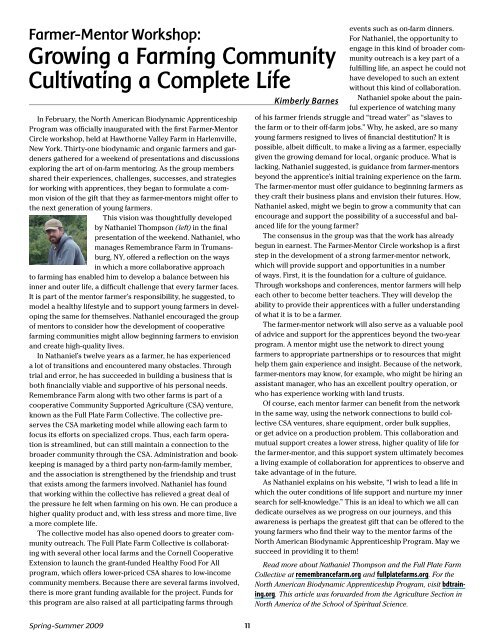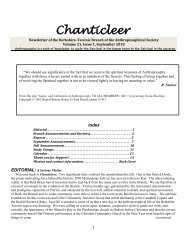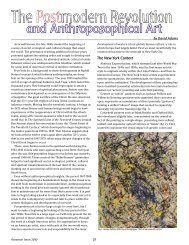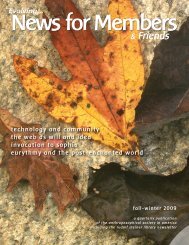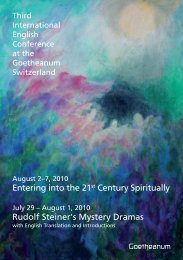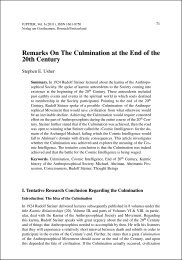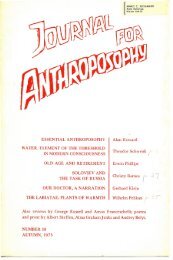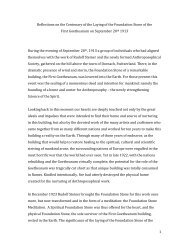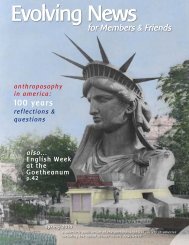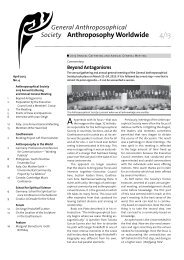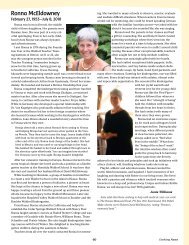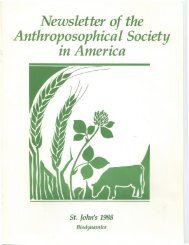Download - Anthroposophical Society in America
Download - Anthroposophical Society in America
Download - Anthroposophical Society in America
Create successful ePaper yourself
Turn your PDF publications into a flip-book with our unique Google optimized e-Paper software.
Farmer-Mentor Workshop:Grow<strong>in</strong>g a Farm<strong>in</strong>g CommunityCultivat<strong>in</strong>g a Complete LifeKimberly BarnesIn February, the North <strong>America</strong>n Biodynamic ApprenticeshipProgram was officially <strong>in</strong>augurated with the first Farmer-MentorCircle workshop, held at Hawthorne Valley Farm <strong>in</strong> Harlemville,New York. Thirty-one biodynamic and organic farmers and gardenersgathered for a weekend of presentations and discussionsexplor<strong>in</strong>g the art of on-farm mentor<strong>in</strong>g. As the group membersshared their experiences, challenges, successes, and strategiesfor work<strong>in</strong>g with apprentices, they began to formulate a commonvision of the gift that they as farmer-mentors might offer tothe next generation of young farmers.This vision was thoughtfully developedby Nathaniel Thompson (left) <strong>in</strong> the f<strong>in</strong>alpresentation of the weekend. Nathaniel, whomanages Remembrance Farm <strong>in</strong> Trumansburg,NY, offered a reflection on the ways<strong>in</strong> which a more collaborative approachto farm<strong>in</strong>g has enabled him to develop a balance between his<strong>in</strong>ner and outer life, a difficult challenge that every farmer faces.It is part of the mentor farmer’s responsibility, he suggested, tomodel a healthy lifestyle and to support young farmers <strong>in</strong> develop<strong>in</strong>gthe same for themselves. Nathaniel encouraged the groupof mentors to consider how the development of cooperativefarm<strong>in</strong>g communities might allow beg<strong>in</strong>n<strong>in</strong>g farmers to envisionand create high-quality lives.In Nathaniel’s twelve years as a farmer, he has experienceda lot of transitions and encountered many obstacles. Throughtrial and error, he has succeeded <strong>in</strong> build<strong>in</strong>g a bus<strong>in</strong>ess that isboth f<strong>in</strong>ancially viable and supportive of his personal needs.Remembrance Farm along with two other farms is part of acooperative Community Supported Agriculture (CSA) venture,known as the Full Plate Farm Collective. The collective preservesthe CSA market<strong>in</strong>g model while allow<strong>in</strong>g each farm tofocus its efforts on specialized crops. Thus, each farm operationis streaml<strong>in</strong>ed, but can still ma<strong>in</strong>ta<strong>in</strong> a connection to thebroader community through the CSA. Adm<strong>in</strong>istration and bookkeep<strong>in</strong>gis managed by a third party non-farm-family member,and the association is strengthened by the friendship and trustthat exists among the farmers <strong>in</strong>volved. Nathaniel has foundthat work<strong>in</strong>g with<strong>in</strong> the collective has relieved a great deal ofthe pressure he felt when farm<strong>in</strong>g on his own. He can produce ahigher quality product and, with less stress and more time, livea more complete life.The collective model has also opened doors to greater communityoutreach. The Full Plate Farm Collective is collaborat<strong>in</strong>gwith several other local farms and the Cornell CooperativeExtension to launch the grant-funded Healthy Food For Allprogram, which offers lower-priced CSA shares to low-<strong>in</strong>comecommunity members. Because there are several farms <strong>in</strong>volved,there is more grant fund<strong>in</strong>g available for the project. Funds forthis program are also raised at all participat<strong>in</strong>g farms throughevents such as on-farm d<strong>in</strong>ners.For Nathaniel, the opportunity toengage <strong>in</strong> this k<strong>in</strong>d of broader communityoutreach is a key part of afulfill<strong>in</strong>g life, an aspect he could nothave developed to such an extentwithout this k<strong>in</strong>d of collaboration.Nathaniel spoke about the pa<strong>in</strong>fulexperience of watch<strong>in</strong>g manyof his farmer friends struggle and “tread water” as “slaves tothe farm or to their off-farm jobs.” Why, he asked, are so manyyoung farmers resigned to lives of f<strong>in</strong>ancial destitution? It ispossible, albeit difficult, to make a liv<strong>in</strong>g as a farmer, especiallygiven the grow<strong>in</strong>g demand for local, organic produce. What islack<strong>in</strong>g, Nathaniel suggested, is guidance from farmer-mentorsbeyond the apprentice’s <strong>in</strong>itial tra<strong>in</strong><strong>in</strong>g experience on the farm.The farmer-mentor must offer guidance to beg<strong>in</strong>n<strong>in</strong>g farmers asthey craft their bus<strong>in</strong>ess plans and envision their futures. How,Nathaniel asked, might we beg<strong>in</strong> to grow a community that canencourage and support the possibility of a successful and balancedlife for the young farmer?The consensus <strong>in</strong> the group was that the work has alreadybegun <strong>in</strong> earnest. The Farmer-Mentor Circle workshop is a firststep <strong>in</strong> the development of a strong farmer-mentor network,which will provide support and opportunities <strong>in</strong> a numberof ways. First, it is the foundation for a culture of guidance.Through workshops and conferences, mentor farmers will helpeach other to become better teachers. They will develop theability to provide their apprentices with a fuller understand<strong>in</strong>gof what it is to be a farmer.The farmer-mentor network will also serve as a valuable poolof advice and support for the apprentices beyond the two-yearprogram. A mentor might use the network to direct youngfarmers to appropriate partnerships or to resources that mighthelp them ga<strong>in</strong> experience and <strong>in</strong>sight. Because of the network,farmer-mentors may know, for example, who might be hir<strong>in</strong>g anassistant manager, who has an excellent poultry operation, orwho has experience work<strong>in</strong>g with land trusts.Of course, each mentor farmer can benefit from the network<strong>in</strong> the same way, us<strong>in</strong>g the network connections to build collectiveCSA ventures, share equipment, order bulk supplies,or get advice on a production problem. This collaboration andmutual support creates a lower stress, higher quality of life forthe farmer-mentor, and this support system ultimately becomesa liv<strong>in</strong>g example of collaboration for apprentices to observe andtake advantage of <strong>in</strong> the future.As Nathaniel expla<strong>in</strong>s on his website, “I wish to lead a life <strong>in</strong>which the outer conditions of life support and nurture my <strong>in</strong>nersearch for self-knowledge.” This is an ideal to which we all candedicate ourselves as we progress on our journeys, and thisawareness is perhaps the greatest gift that can be offered to theyoung farmers who f<strong>in</strong>d their way to the mentor farms of theNorth <strong>America</strong>n Biodynamic Apprenticeship Program. May wesucceed <strong>in</strong> provid<strong>in</strong>g it to them!Read more about Nathaniel Thompson and the Full Plate FarmCollective at remembrancefarm.org and fullplatefarms.org. For theNorth <strong>America</strong>n Biodynamic Apprenticeship Program, visit bdtra<strong>in</strong><strong>in</strong>g.org.This article was forwarded from the Agriculture Section <strong>in</strong>North <strong>America</strong> of the School of Spiritual Science.Spr<strong>in</strong>g-Summer 200911


